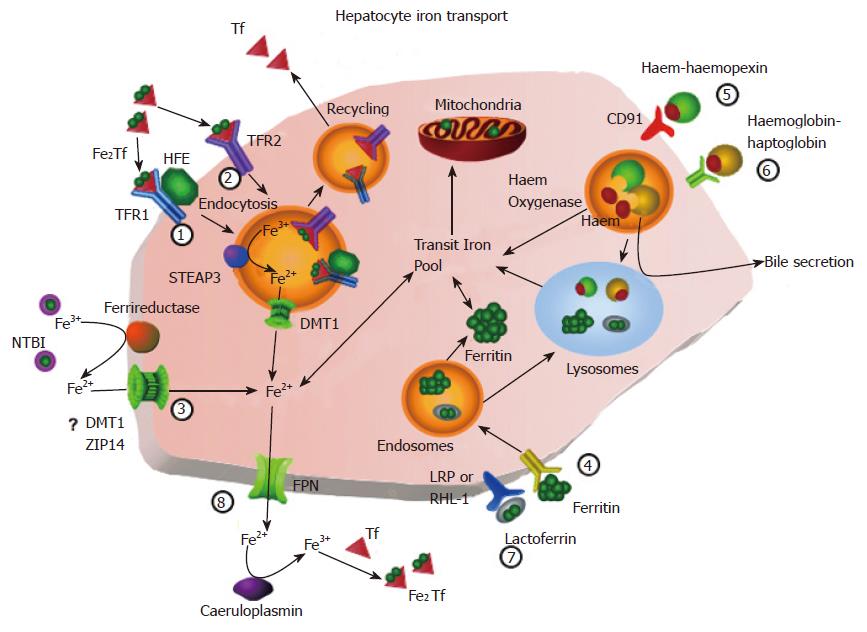Copyright
©2007 Baishideng Publishing Group Co.
World J Gastroenterol. Sep 21, 2007; 13(35): 4725-4736
Published online Sep 21, 2007. doi: 10.3748/wjg.v13.i35.4725
Published online Sep 21, 2007. doi: 10.3748/wjg.v13.i35.4725
Figure 1 Hepatocyte iron transport.
(1) TFR1-mediated uptake of diferric transferrin. Diferric transferrin binds to its specific receptor and is endocytosed. The endosome is acidified and Fe3+ is reduced by STEAP3. The iron is released and transported out of the endosome via DMT1 and apotransferrin is exocytosed. (2) TFR2-mediated uptake of transferrin. This mechanism is similar to the TFR1-specific mechanism except that transferrin binds to TFR2. (3) Uptake of NTBI. Iron is reduced and is transported into the cell via a carrier-mediated process. (4) Uptake of ferritin. Ferritin binds to its specific receptor and is endocytosed. The endosome is directed to lysosomes and the iron is transferred to the transit pool or endogenous ferritin. (5) Uptake of haem-haemopexin. The haem-haemopexin complex binds to its specific receptor CD91 and is endocytosed. Haem is removed and is degraded by haem oxygenase. (6) Uptake of haemoglobin-haptoglobin. The haemoglobin-haptoglobin complex binds to a specific receptor. Following endocytosis, the complex may be directed to the canalicular membrane for release into the bile or to the lysosomes for degradation. (7) Uptake of lactoferrin. Lactoferrin binds to LRP or RHL-1 and is endocytosed and targeted to the lysosomes for degradation. (8) Iron release Iron is released by FPN and oxidised by caeruloplasmin and binds to apotransferrin. TFR1, transferrin receptor 1; TFR2, transferrin receptor 2; STEAP3, six-transmembrane epithelial antigen of the prostate 3; DMT1, divalent metal transporter 1; NTBI, non-transferrin bound iron; ZIP14, zinc-regulated transporter and iron-regulated transporter-like protein 14; LRP, low-density lipoprotein receptor-related protein; FPN, ferroportin.
- Citation: Graham RM, Chua AC, Herbison CE, Olynyk JK, Trinder D. Liver iron transport. World J Gastroenterol 2007; 13(35): 4725-4736
- URL: https://www.wjgnet.com/1007-9327/full/v13/i35/4725.htm
- DOI: https://dx.doi.org/10.3748/wjg.v13.i35.4725









